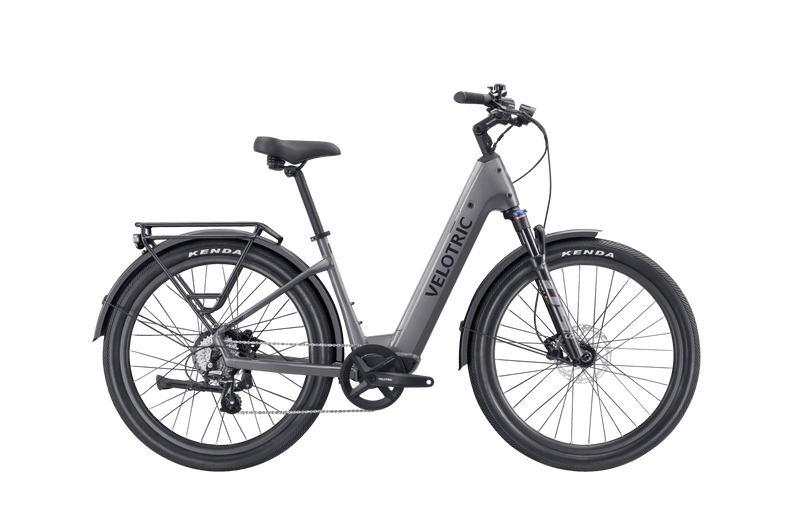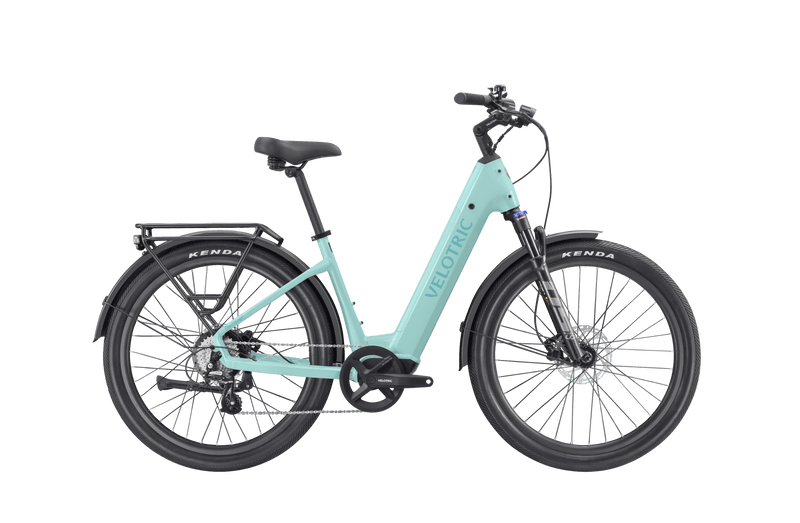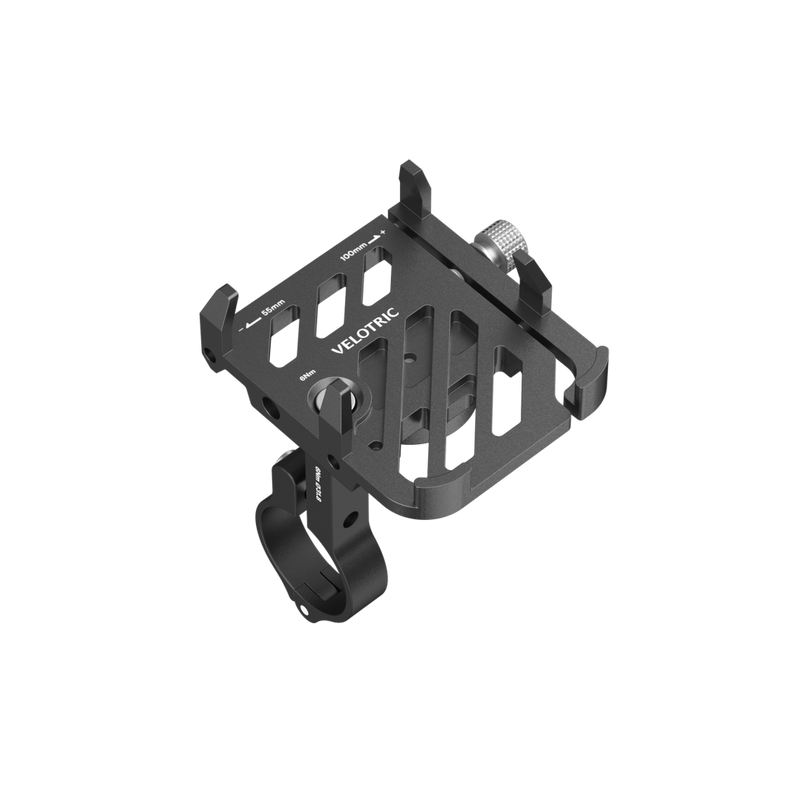One important component sets an electric bicycle apart from a traditional bicycle: the motor. Unlike a traditional vehicle, an e-bike motor doesn’t run on gasoline. Instead, it’s powered by a battery.
Without the battery, an electric bike is just a regular bike. The electric motor won’t work if the battery isn’t powering it.
This means you’d have to pedal all the time. You wouldn’t be able to use functions like pedal assist (which helps power the bike forward when you’re pedaling) or throttle assist (which propels the bike forward even when you aren’t pedaling). In short, you’ll miss out on some of the biggest perks of riding an e-bike!
Needless to say, the battery is one of the most important e-bike components. Understanding the different types of e-bike batteries and how they work can help you pick an e-bike with a fitting battery for your needs.
Below, we cover the basics of e-bike batteries and provide some practical tips for caring for your e-bike battery so you can preserve its life span. Let’s get to it.
What is an electric bike battery, and how does it work?
E-bike batteries provide the electricity to power the bike’s motor. The battery is removable, so it can be detached from the bike and recharged. This is done by placing the battery in a charging port (the battery charger is plugged into the wall).
Types of electric bike batteries
There are different types of e-bike batteries. Here are three popular options, with an overview of the pros and cons of each.
Lead-acid batteries
The lead-acid battery is as old-school as they come, with roots dating back to the 1850s. This type of battery is affordable, compact, and easy to recycle.
However, lead-acid batteries are heavier than lithium batteries and nickel batteries. They also have less capacity than nickel or lithium batteries.
Since lead-acid batteries don’t have great capacity, they’re best for cyclists planning short commutes. For longer rides, you’ll want something with greater capacity. Lead-acid batteries can also work well for kids with small, lightweight e-bikes.
Lithium-ion battery (Li-Ion)
Lithium-ion batteries are the most popular batteries currently on the market. They have good capacity without being too heavy, allowing for sufficient longevity and range.
Another pro of lithium-ion batteries is that they can be molded into various shapes. Li-ion batteries are categorized into three main groups: lithium-manganese (LiMg204) batteries, lithium-cobalt (LCo) batteries, and lithium-ion polymer (LiPo) batteries.
Lithium-ion batteries are more expensive than traditional lead-acid alternatives. However, the increased capacity usually makes the investment worth it. Opt for a lithium-ion battery if you want reliable power for longer rides.
Lithium iron phosphate (LiFePo4)
Lithium iron phosphate (LiFePO4) batteries are newer and not as well established as the “mainstream” lithium-ion battery. However, LiFePO4 batteries show a lot of promise.
For one thing, they have a longer life span and better charge efficiency. They also hold up well across a range of temperatures and weather conditions. The drawback of this battery type? The price.
Since LiFePO4 are new to the market, they’re still scarce, making them more expensive. That said, they have a long life span, making them worth investing in.
Factors to consider when buying your electric bike battery
Battery type is only one consideration when picking a bike battery. You also want to consider the below points when shopping around.
Capacity
Battery capacity is usually measured in watt-hours. Watt-hours tell you how much power the battery can hold. The more watt-hours a battery has, the larger the e-bike’s range — how far you can ride it on a single battery charge.
You can calculate watt-hours by multiplying an e-bike’s amp hours by its voltage. Amp-hours (Ah) refers to how big your e-bike’s gas tank is. For example, Velotric’s e-bikes have 14.4Ah. A higher Ah number gives the bike more range.
That said, be aware that cycling style can impact range. So, if you’re riding uphill and engaging pedal assist at a high level, you’ll put more strain on the motor and drain the battery faster. The result? Less range.
Weight
Bigger doesn’t necessarily mean better when it comes to e-bike batteries. While a big battery may have more capacity, it will also weigh more. This can add a burden to the e-bike and reduce the range.
A bulky e-bike battery can also impede bike performance and handling. For example, a heavy battery can disrupt the e-bike’s equilibrium, so it’s unbalanced. For instance, you may notice that the bike’s weight isn’t evenly distributed when making tight turns.
Finally, a heavy e-bike battery makes your entire e-bike less portable. This is a major consideration if you have to lug your e-bike up and down stairs. Also, carrying extra battery packs can be a pain if the batteries are heavy.
Voltage
You’ll see e-bike batteries listed with a “V” measure — that “V” stands for volt. For example, Velotric’s e-bike batteries are 48V. Voltage determines how much power is delivered to the bike motor and affects how quickly the e-bike can accelerate.
E-bike battery voltage is comparable to a car’s horsepower (how much power the car engine produces). The higher the voltage, the more power the bike has. This means it can reach high speeds faster.
Charging time
Bike batteries also differ in terms of charging time (how long you have to plug them into the charger to “refuel” them). Charging time is determined by the battery’s capacity and charger traits like voltage settings and output current.
If you’re planning a longer ride, it’s important to know the battery’s range and its charging time. You don’t want to hit an unexpected delay because your battery runs out, and you have to wait for it to recharge.
For context, Velotric’s e-bike batteries are juiced up to 100% in just six hours.
Maintenance requirements
Different e-bike batteries require different levels of maintenance. For example, a nickel-cadmium battery will require more care than a standard lithium-ion model.
That said, all batteries require some attention. If you don’t care for your battery, you run the risk of shortening its life span and having to buy a new battery sooner.
Read on for some basic battery maintenance tips.
Tips for taking care of your electric bike battery
You can help preserve your e-bike battery’s life span by caring for it properly. Here are some battery care steps to include in your general e-bike maintenance plan.
Charge regularly
If you ride your e-bike regularly, you’ll need to charge it regularly. After all, you don’t want it to run out of juice mid-ride!
But what about if you aren’t using your bike for a period of time? For example, you might only use your e-bike in the warmer months, preferring not to ride in snowy or icy winter conditions.
Here’s a quick tip that many new e-bike owners aren’t aware of: Even if you aren’t using your e-bike regularly, you should still charge the battery regularly! The battery can more easily negotiate the self-discharge process if it’s charged regularly.
Just how often is “regularly,” though? If you aren’t using your e-bike, you should typically charge the battery every two to three months. You should also charge the battery fully once per month (but not more — find out why too many full-charge cycles are bad below).
Store in a cool place
It’s best to store your battery at room temperature, from about 50 to 77 degrees Fahrenheit. Excessively high or low temperatures can damage the battery and shorten its life span.
Keep the battery in a cool, dry place when it’s hot out. Translation: Don’t leave it sitting in the blazing sun! If you’re parking your bike outside on a summer day, make sure to leave it in the shade.
You can use thermal protective covers to keep the battery snug and secure when it’s cold out. Remember, the e-bike battery is removable, so you can take it out and bring it inside to protect it against extreme temperatures.
These temperature rules also apply when charging — charge only at room temperature. You can buy battery monitoring systems (BMS) to help regulate battery temperature. These are installed between the battery and the wires to monitor the battery’s status and control the charge and discharge process.
Don’t overcharge
You might think the best way to ensure your battery never runs out of juice is to keep it charged to 100% at all times. Think again! Overcharging your battery can actually be bad, placing excess strain on the system’s battery cells.
Ideally, you’ll keep your battery charged around 30% to 70% full. A battery will wear out a lot faster if it’s completely charged, reducing its performance and resulting in complete failure.
That said, you don’t want to undercharge. If the battery is drained and needs to be charged from zero, this likewise creates extra stress for the battery cells. See our tip “charge regularly” above!
Clean the connectors
Dust and grime can prevent proper charging if the electric bike connectors are dirty. Clean the connectors at least once per month — more if you’re a frequent cyclist. You should also always clean the connectors after a particularly messy ride, for example, in muddy or rainy conditions.
You can clean the connectors with a soft-bristled toothbrush dampened with soapy water or rubbing alcohol. This will help reduce the buildup of dust, which can potentially cause issues with the battery’s components and wiring — even leading to short circuits or, worst-case scenario, a total battery failure.
Another option is to use a compressed air can to remove particles. You can use a computer keyboard cleaner, for example. This will help remove residue and reduce the risk of corrosion, which can damage the battery.
Check the battery condition frequently
When you do your regular e-bike maintenance, check details like tire pressure and brake pads. Also, make a point of checking your battery. Start by testing your battery charge level and ensure the battery is properly charging.
You should also inspect the battery for any signs of damage, such as dents or corrosion. Never ride with a damaged battery. Not only is there a higher risk that you’ll run out of power prematurely, but this can also be a potential safety hazard.
How often should you give your bike and the battery a thorough once-over? If you ride regularly (say, 1,000 miles per week or more), we recommend a thorough check every three to four months.
Discover the best Velotric e-bike options for you
A great e-bike requires a great battery. That’s why Velotric e-bikes come with a high-quality, tried-and-tested battery that you can count on.
Our e-bikes include a removable battery made by Samsung. The 48V 14.4Ah lithium-ion battery reaches 100% charge level in just six hours and is certified by Underwriters Laboratories (UL 2271), one of the highest safety standards in the e-bike industry.
With the Velotric Discover 1, you’ll enjoy a range of up to 65 miles, 50% longer than similar e-bikes on the market. With the Nomad 1, you’ll get a range of up to 55 miles. While this is slightly less (because of the fat tire bike’s larger size), it’s still 50% longer than similar e-bikes.
Velotric’s e-bikes also come with hydraulic disc brakes, front and rear fenders, and reflectors and lights. You can ride with confidence knowing your e-bike is equipped with all the essentials.
Whichever e-bike you choose, you’ll get a new, top-quality e-bike battery pack with reliable battery life, impressive range, and a one-year warranty. Your charger is also included.
Ready to ride? Find your new e-bike today.























































